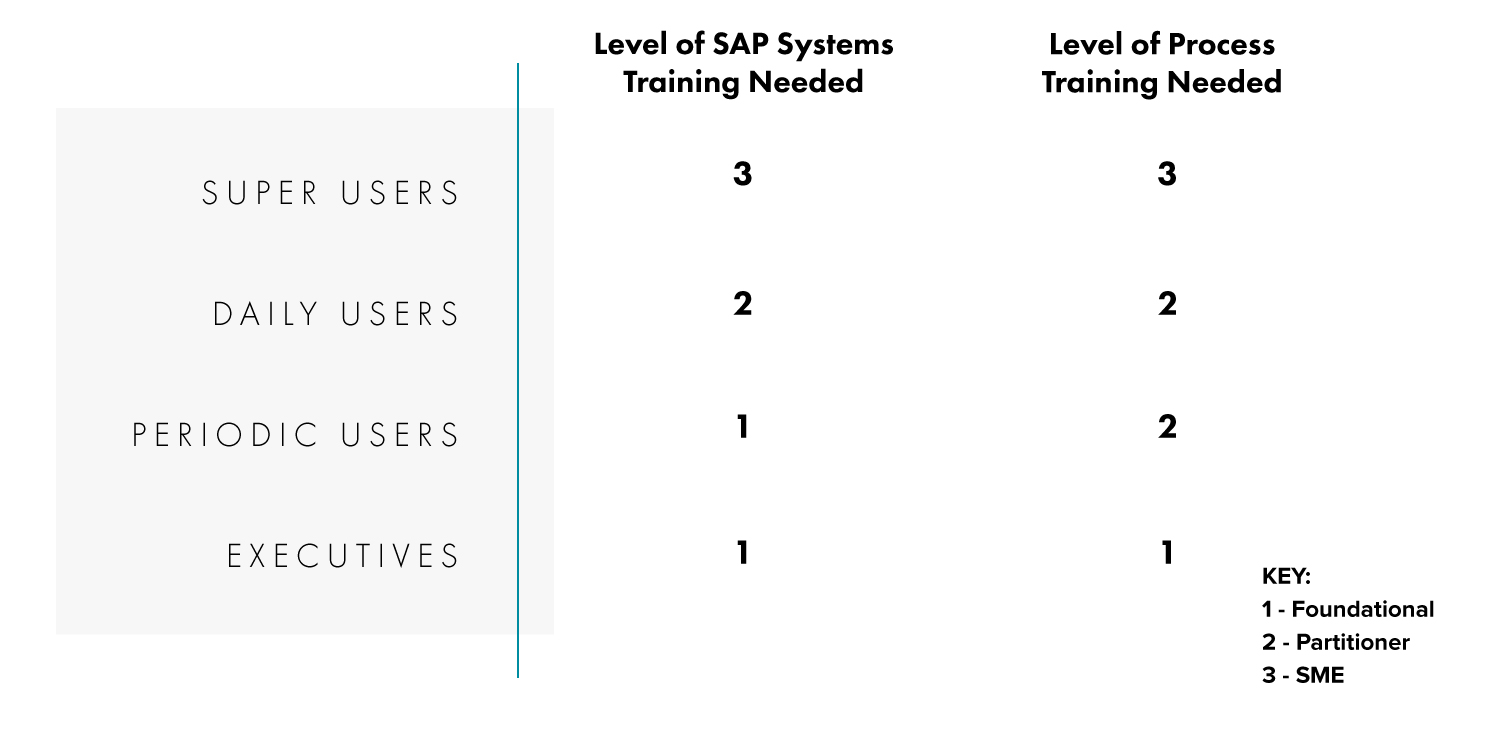A Comprehensive Approach to SAP End-User Training
SAP End-User training shouldn’t be overlooked when it comes to coordinating your implementation. The planning and execution of an SAP implementation is robust and thorough – to ensure that the system supports the needs of the business and that the organization is well-equipped to use it. The latter is sometimes left as an afterthought: the training and change management components of the implementation. We’re seeing an upward trend of organizations starting to realize the criticality of effective training and change management in SAP implementations and its direct correlation to a successful implementation. Leadership is realizing that a great system and processes without proper training will jeopardize the investment and lead to the “old” way of doing business. Particularly when upgrading from ECC to S/4HANA, the shift in functionality and user experiences requires a comprehensive focus on effective training. In this post, we’ll focus on the “training” piece of the equation; we’d like to share some of the building blocks that differentiate a truly comprehensive, robust SAP End-User training program to those that are less so.
The Ultimate Goal of End-User Training
A good SAP end-user training program is effective and timely: it should be tailored to the tasks the business will be required to perform as well as the contextual process knowledge. Secondly, it must be sustainable – the maintenance and reusability of the course content should be a consideration embedded within the early stages of planning, as should a continuous support model.
Key Factors Impacting End User Training
When designing an SAP end-usertraining program, there are a few key considerations to be accounted for:
1. Learner Analysis – What are the different groups of “users” based on how they’ll be using the system, what functional groups they belong in, and how involved they are with the implementation project? A mapping exercise to determine what the groups are and who belongs in each group is needed to ensure a systematic and targeted approach to training the organization. For example, the approach for Super Users would be different from other End Users, as would it for those part of the core implementation team. Once the segmentation activity is complete, we’d evaluate their current level of understanding of the processes/system knowledge the level they need to reach, how their current responsibilities compare with the new responsibilities post-implementation, as well as other logistical details such as their location.
A sample high-level categorization of the user types may look like the following:

2. Training Approach – Knowing the learner groups will guide the training approach. All the learner groups should receive the general “big-picture” communications/training to help the business understand the strategic importance of the implementation and knowing how to use the system well. From there, a high-level end-to-end process training will be conducted to illuminate how the system interacts with the processes, and in return how each role is critical in ensuring the system works effectively. The next level of training is more tailored and includes the specific process areas and each role’s new responsibilities. Tactically, it may include an overview of the specific process, new contextual procedures, basic navigation of the system, and specific task-based training. In this article, we talked about leveraging various modalities of training to ensure high knowledge retention. Impactful SAP end-user training contains, at minimum, the following:
- Concepts – this is usually PowerPoint slides that provides information about the business process, integration points, upstream and downstream impacts, terminology, as well as how to perform a task in the system. It comes down to answering the following: who, what when, where, why and how.
- Hands-on learning – normally, this involves instructor-led demonstrations of system tasks and hands-on activities the user performs in a safe, non-production environment so they can touch and feel the system. The use of this sandbox environment allows users to continue practicing beyond the formal training classes.
- Job aids and other reference materials – this is a broad term to describe the various performance support documents available, such as simulations, business process procedures, work instructions and other documents to guide learners beyond the formal training as they’re using the system and going about their day-to-day duties
Additionally, there are usually mentors and Super Users to continue the education beyond the formal training, as well as other support activities (usually coordinated by the Training and Change Management teams during the project, and embedded within the normal business operations following Go-Live). An example is the concept of “office hours” where Super Users and other Subject Matter Experts are available for questions during certain time windows. This touches upon a key aspect of successful SAP training, which is the sustainability consideration: enabling the organization to sustain the maintenance of the training post go-live is critical, as well as decisions on what training new hires will complete and timeframe for “refresher” training following the initial training.
3. SAP Deployment Strategy – What is the deployment plan/schedule? Should a wave-based training schedule be considered to mirror the deployment approach? Will there be competing priorities for the learners? It’s important to intertwine training (as well as change management) activities in a thoughtful way into the implementation project plan both to ensure cohesiveness of messaging and expectation-setting within the organization, as well as capitalizing on synergies.
The training approach should be coordinated closely with the deployment timeline: if the business is trained too early prior the system being deployed at their site or for their function, additional refresher training(s) may need to be considered. On the contrary, training that is conducted too late risks performance disruptions due to insufficient learning time.
Project deliverables, such as Business Process Documents developed by the project team, could serve as a starting point for course content development. This involves a close coordination of the activities within both the functional team and the training team – when done well, deliverables could be created in an agile manner with fewer resources and shorter timeline. However, good planning and SME guidance are needed to ensure the synergies are valid and do not result in re-work; for example, a Learning & Development expert may advise that certain granular details within a Test Script deliverable may be too granular to be used as a training document. Missing the critical balance could mean a disengaged or frustrated learner audience doubting the relevance and impact of the training. We’ve also seen project teams engage the business users in testing/validation activities for the secondary objective of providing early exposure to the system and leveraging the experience as a “pilot” of upcoming training. These considerations help ensure a synchronized approach between training and other project activities, reduce the burden on the business, and all the while gleaning early insight into user feedback.
Summary
A successful SAP implementation hinges upon many factors – a reliable and experienced System Integrator as a partner to plan holistically and execute diligently, support of Leadership, the focus of the business to participate actively in the project activities, and a well-designed training and change management plan. Some of our key learnings shared within this post highlights the ways to leverage training to influence how the business embrace and use the new system, so that the benefits of the implementation can be fully realized.




